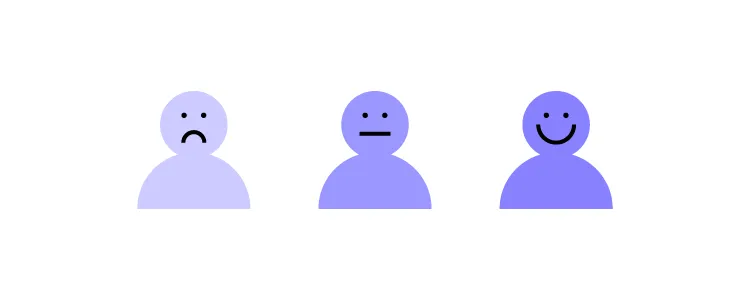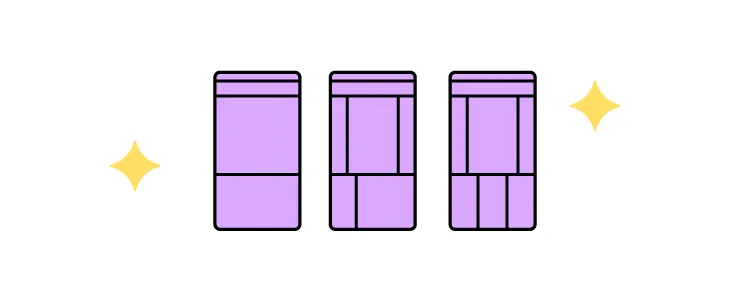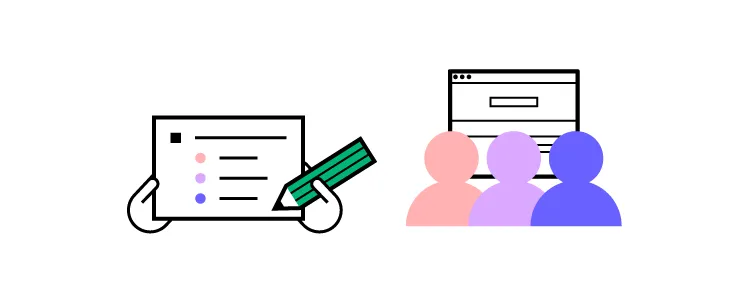What is Desirability, Viability, and Feasibility? [+ Design Review Template]
According to IDEO, a truly innovative product must have desirability, viability, and feasibility for sustainable long-term growth and success.
The design thinking process involves research, or a design review, to determine what product and features will serve your customers the best. A successful design review identifies a problem your competitors aren’t solving that will benefit both your end-users and the business.
But, where do you start? How do you find this competitive edge? And how do you know if it’s a viable business model that serves users and the organization?
This article explores research during the conceptualization phase of design thinking and how to identify an idea that meets three key criteria:
- Desirability – is a need that the user have to use a product.
- Viability – is a commercial value of releasing a product.
- Feasibility – is practical and technical constraints of creating a product.
Does your design tool provide you with features to take a product from concept to design handoff? UXPin is an advanced end-to-end design tool that makes it easy to create prototypes with live React, Storybook or npm components. Check why this approach to prototyping can help you. Discover UXPin Merge.
What are Desirability, Viability, and Feasibility in Design?
Desirability, viability, and feasibility is a design thinking methodology to test ideas, concepts, and hypotheses to determine if you have a unique value proposition (aka unique selling point) and whether it’s worth pursuing.
Without checking all three boxes, you increase the risks, costs, and potential for failure. You could say desirability, viability, and feasibility are a risk analysis methodology for ideas – a toolkit to find that innovation sweet spot.
By applying this methodology, you can pinpoint the weak points in your design concepts, do further research or scrap the idea and move on.
Where Does this Methodology Originate?
IDEO, a global design company, conceptualized the desirability, viability, and feasibility design thinking methodology in the early 2000s as a way to test ideas.
IDEO recognized that the best ideas succeed when they fulfill this trifecta. Conversely, “great ideas” often fail when they miss one or more of these three criteria.
Let’s look through these three lenses to understand how this trifecta fits together.
Desirability
The first box designers must check is desirability. If your product idea has no market value and people don’t want or need it, it won’t sell.
Researching desirability will also tell you whether your product is a want or a need. For example:
- You need to get to work which you can do by walking, taking public transport, driving, carpooling, etc.
- You want a car to get to work because it offers convenience, and maybe more luxury than public transport.
A need is something your customers cannot live without, while a want is often a more desirable option to fulfilling that need. Both check the box for desirability, but a product that fulfills someone’s need is far more valuable than something someone wants or is “nice to have.”

To find a desirable product, you must research your customers and identify pain points (wants and needs) that you can fulfill.
- Does your product solve someone’s problem?
- Do your competitors offer a solution?
- Do you have a better idea?
- What makes your idea unique, and why would someone choose yours over the competition?
- How will your product make end-users feel?
- Is your product so desirable that people will tell their friends?
- Will your product be something that once people try it, they won’t want to live without it?
When researching desirability, the intention is to stress-test your idea to find the gaps that need fixing. The more gaps you fill, the stronger your product and the better it will stand up against rigorous stakeholder questioning and customer satisfaction.
Viability
Viability tells you whether or not your product makes business sense. Even if you have the most desirable product in the world, if it’s too expensive or isn’t profitable, then it’s not a good business model.
A truly viable product idea makes business sense in the short-term and into the future. The quicker and longer it can deliver a positive return on investment, the higher the viability of your design idea.

A fantastic example of viability is how Coca-Cola designed a beverage formula in 1886 that’s still one of the most consumed drinks in the world today! That initial investment created massive wealth for its inventors and still delivers incredible returns for shareholders more than 135 years later.
Viability is also about societal and environmental impact—the ethical aspect of your design. Will your digital product provide a positive gain for society? In 2021, Facebook whistleblower Frances Haugen released documents showing that the social media giant’s internal research showed that Instagram creates anxiety, depression, and suicidal thoughts among teenage girls.
Instagram might deliver high financial returns in the short term, but is this harm to teenagers sustainable long-term? And what will governments do to regulate Facebook and Instagram?
Facebook is a massive company with the resources to overcome societal controversy, fines, and lawsuits. But, a smaller company or startup will mostly like fold when confronted with similar pressures.
So, when we look at viability, it must provide value for the business, customers, and society. Some questions you might want to consider include:
- What has to be true for this design to work?
- What will it cost to turn your design into a functioning product?
- Do you have the capital investment to build the new product or feature?
- What is the pricing model? And, can the business make a profit?
- How long will it take to see a positive return on investment?
- Is the product sustainable?
- How does the product impact society?
Like desirability, viability requires you to research, analyze, and stress-test ideas to ensure they’re viable and sustainable.
Feasibility
Feasibility looks at your current resources to determine if you’re capable of developing the product in the foreseeable future. Designers must consider how the product will impact the business.

Some feasibility factors include:
- Technical constraints
- Financial constraints
- Product’s impact on branding, marketing, customer support, and other areas of the business
- Estimated time-to-market
- Operational capabilities
Ideally, you want to design a new product or feature within the company’s current capabilities using available resources. When you have to build infrastructure to support a new product, you increase the risks and costs.
Here are some feasibility questions you might want to consider when designing a new product or feature:
- Does the current design system have the components to develop the new product?
- How long will it take to design and develop the product?
- Do you have enough product designers, UX designers, and engineers to build and scale the new product?
- Can our technical constraints support the new design?
- Will the organization need to hire new talent?
- If you have to extend the organization’s capabilities, how can this benefit future products?
- What impact will the product have on the brand?
- Will the product’s release impact other areas of the organization, like marketing, sales, and customer support? And do these departments have the capacity for more work?
Using Desirability, Viability, and Feasibility in a Design Review
Organizations conduct a design review during the early stages of a product design to evaluate the design against specific criteria. The goal is to identify any problems with the design or prototype before developing it–which carries the costs of infrastructure, marketing, sales, customer support, and more.
Essentially, the organization wants to know the product design’s desirability, viability, and feasibility.
A UX Design Review Template
Applying the desirability, viability, and feasibility design thinking methodology will give you the insights and data to present a comprehensive and objective design review to stakeholders.

Below is a structure or template you can use to present your design review so that it’s easy for stakeholders to read and digest.
The problem: State the problem succinctly. The design and business teams will build a shared understanding from this foundation.
The system (current state): Show how the current system works (if it’s an existing product) to help put the problem in context. Later, you can show how the system could work with your proposed experience.
The Jobs To Be Done (JBTD): A shared understanding of what motivates your customers is crucial for a design review. As Tony Ulwick defines JBTD: “a lens through which you can observe markets, customers, user needs, competitors, and customer segments differently, and by doing so, make innovation far more predictable and profitable.” This lens helps stakeholders understand how customers decide whether to “hire” or “fire” your solution.
The business objective: State the business value and ROI for solving this customer problem.
The metrics that matter: You can’t improve what you don’t measure. These metrics should enable you to quantify the business and customer value you’ll create through your new product design.
The proposed experience: Summarize the proposal in a sentence. Make it clear and understandable. The people in the room need to understand how this proposal relates to the problem you’ve previously articulated.
The implications of your proposal: How will your proposal impact other parts of the business? Maybe you don’t know. Understanding this early in the product design process is critical to achieving balance in desirability, viability, and feasibility.
Basic experience design: Present your wireframes, mockups, prototypes, or minimum viable product (MVP) so that stakeholders can visualize how a customer might find the product desirable.

Insights informing the design: What led you to choose this design? What were the insights, hypotheses, etc.? Show your depth of thought in a few bullet points.
Hypotheses about the new design:
- What are your hypotheses about the new design?
- How did you arrive at this hypothesis?
- How can you align these hypotheses to the metrics you believe matter?
These should be clear and testable. By conducting tests with clear pass/fail metrics, these hypotheses should also give you a strong foundation for measuring the incremental progress you’re making.
The team’s collaborative focus: Why are you all in the room? What input do you need from stakeholders? This section of the design review template helps set a clear context and focus for the stakeholders responsible for the product’s success.
With UXPin Merge, you can use built-in component libraries to quickly assemble high-fidelity prototypes and MVPs and present these to stakeholders during the design review. This will definitely speed up your time to market, and make you release quality products faster. Discover UXPin Merge.




